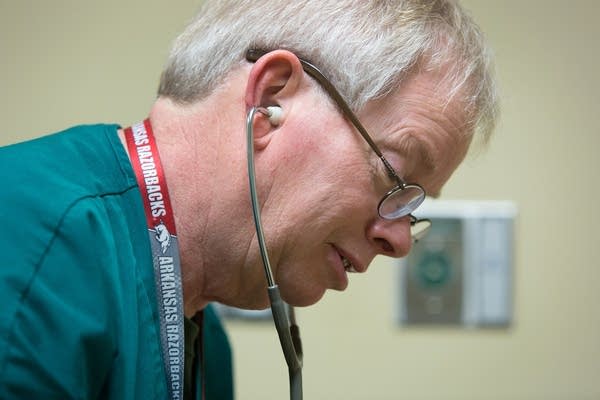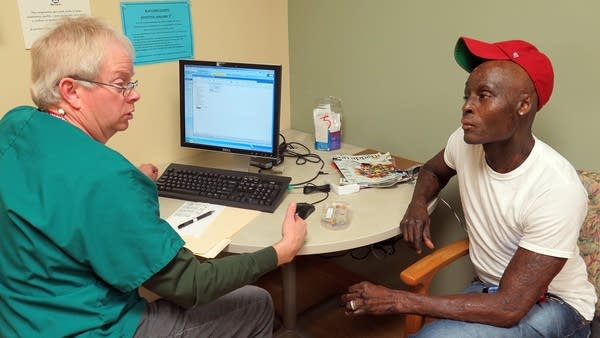30 years later, Minn. doctor still opening doors in fight against AIDS

Go Deeper.
Create an account or log in to save stories.
Like this?
Thanks for liking this story! We have added it to a list of your favorite stories.
Dr. Keith Henry still remembers the first patient he lost to AIDS.
It was late spring 1984 and a young college instructor came to Henry's hospital with an aggressive AIDS-related pneumonia. The man's intelligent banter impressed Henry. But before long, his patient was silenced by a ventilator. Within weeks, he was dead.
It hit Henry hard. He was 31 years old, nearly the same age as the patient.
"That young person's life was snuffed out," he recalled. "That pretty much sealed the deal for me that this was going to be a worthwhile effort to focus my career on."
Turn Up Your Support
MPR News helps you turn down the noise and build shared understanding. Turn up your support for this public resource and keep trusted journalism accessible to all.
The death called Henry into action. Months later, in January 1985, he opened the state's first HIV/AIDS clinic at a public hospital in St. Paul as AIDS and fear of AIDS patients gripped Minnesota and the world. The deadly disease had no cure. Misinformation was rampant about how the virus spread. The fact HIV struck primarily gay men and IV drug users compounded the controversy.
Henry didn't have a lot to offer when he opened his clinic 30 years ago this month. There were no drugs available to treat HIV and AIDS. So he focused on what he could influence. He encouraged his patients to keep their strength up by eating healthier foods. He offered preventive medications to minimize their risk of contracting a deadly pneumonia or other infections.
Most of Henry's patients, however, had been diagnosed with AIDS so late in their disease, they were too sick to benefit much from his efforts.
"Back in the early days you'd no sooner get a new patient you would see and then the patient would die," said Henry.
A few months later, prospects improved slightly when the U.S. Food and Drug Administration licensed the nation's first HIV test, meaning people could learn their HIV status much earlier, before experiencing AIDS symptoms.
Henry offered the test in his clinic and his patient load grew steadily. He estimates his treatments gave his patients another year or so of life. It was better than nothing, but hardly a victory. That wore on Henry.

"The days would just blow by and often I'd be quite exhausted because it was as emotionally draining as it was intellectually draining," he said. "In the first 10 years it was almost overwhelming."
He found himself deeply involved in his patients' lives. Many had lost everything including jobs, housing and family support. If his patients couldn't afford their medications, sometimes Henry would pay for the drugs out of his own pocket.
He fought fiercely for patients during a time when there was a lot of hostility toward people with AIDS and anyone who helped them, said Philip Willkie, who was active then in the gay rights movement.
Willkie remembers attending some tense funerals with the young doctor "where we'd be blamed. The preacher pointed over 'there' (at) 'them' — pointed at us. We were the bad ones? We were there fighting for the person."
Henry was among a half dozen doctors working in hospitals and other newly created HIV clinics, mostly in the metro area. They were all well-regarded, although Henry's research set him apart, said Dr. Frank Rhame, one of Minnesota's early AIDS pioneers.
Henry conducted dozens of studies that answered many questions about HIV and AIDS, Rhame said.
Henry was involved with early studies to find safer needle disposal systems to protect health care workers. His research into an AIDS-related eye disease led to a treatment technique to prevent blindness that's still used.
He had many discouraging findings along the way, too. Things changed, though, in 1996 when researchers discovered that HIV drug combinations, called cocktails, were effective at suppressing the virus.
Henry saw the results in his own patients. Nearly 20 years later, it still brings him goose bumps to think about it. "Literally, I had scores of patients that rose from the dead," he said.

They included Bill Kimker, who was living in a Stillwater hospice, unable to walk or bathe on his own, and preparing to die when Henry gave him the new drug cocktail.
Kimker didn't notice much for the first few months, except that he was still alive after being told he would be dead in two or three months.
Gradually, feeling returned to his right leg and arm. His appetite improved, too. Sixteen months after he entered hospice, Kimker stepped out of his wheelchair and went home. "I was the first person to ever walk out of Hope House on my own two feet and not being carried out on a stretcher," he recalled.
Now 69, Kimker lives in Palm Springs, Calif., and spends his days tending his flower gardens and fruit trees.
Henry's bustling clinic serves 1,800 HIV positive patients today and looks nothing like it did in the early days. Gone is the cramped, basement office at the old St. Paul-Ramsey Medical Center (now Regions Hospital). Henry now shares a ground floor, communal office with more than a dozen other colleagues at Hennepin County Medical Center's Blue Building in downtown Minneapolis.

What opened in 1985 as the Immunodeficiency Clinic is now called the Positive Care Center.
Henry, 61, has changed, too. His once thick mane of brown hair is thinner and completely gray. But his mood is bright. His schedule on a recent day included Chauncey, a 39-year-old patient switching to a new HIV pill that only needs to be taken once a day. MPR News agreed to withhold his last name because his family does not know he's HIV positive.

Chauncey, who's African-American, says his culture still stigmatizes HIV positive people. "We don't educate each other and we don't educate our people to really know what it is," he said. "I think a lot of black people think that if you touch somebody with HIV, you're going to get HIV."
Drug treatments are so effective these days that Henry believes HIV could be wiped out in a generation if everyone who has the virus gets treated. But the stigma and lingering fears about HIV in some ethnic communities are keeping too many from getting the help they need, he said.
In the past decade, new HIV cases in Minnesota have held steady at around 300 infections annually. Henry tries to keep it in perspective by remembering how far many of his patients have come.
"People kind of wonder why I walk around the clinic smiling when it's a crappy day outside and bad things are happening," he said. "I go, 'Yes, but you don't know what things used to be like.'"


